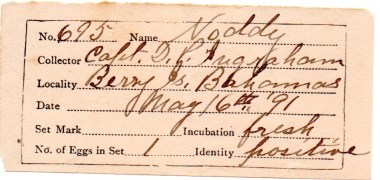Captain David Powers Ingraham was born in New York on August 28, 1836 to Allen W. Ingraham (1798-1872) and Caroline F. Powers (1801-1876). At some point, his family moved to Michigan as they are listed in the 1840 Federal Census. At age 23 (1860) he was a farmer living with his parents and two siblings in Brooklyn, Michigan.
David went into the Civil War in November of 1862 serving in the Michigan 9th Cavalry. In 1863 he was promoted to 2nd Lieutenant and to 1st Lieutenant in 1864. He was Captain by the time he mustered out in 1865.
He married Helen May “Nellie” Clark (1840-1922) of Pennsylvania in 1870. They did not have any children.
Occupations throughout his life were farmer, miller, insurance agent, naturalist, and he was a postmaster at the time of his death in 1904 (age 67). He homed in New York, Pennsylvania and Colorado.
David collected birds, eggs and a mammal. He collected specimens for the Smithsonian, colleges and other museums.
His collecting of the Audubon’s Shearwater was published in 1889 with the specimen going to the U.S. National Museum’s collection. His egg data on six species was published in 1904 and 1914. He wrote an extensive observation paper on the American Flamingo of Florida in 1893 and presented it to the World’s Congress on Ornithology. It was also presented in 1896.
David discovered a rat-like rodent, the Bahamian hutia (aka Ingraham’s Hutia), in the Bahamas in 1891. Dr. J.A. Allen (Curator of Mammals & Birds at American Museum of Natural History) named it after him, Geocapromys ingrahami. The B. Hutia is currently critically endangered. David corresponded with Franklin Fairbanks of the Fairbanks Museum in Vermont, and a specimen was sold to him for $1.00, and several went to the American Museum of Natural History. David called it a “hamster” or “Hootie”.
Sources: Ancestry.com, Findagrave.com, Biodiversitylibrary.org, Newspapers.com, Royalsocietypublising.org
There are seven sets of eggs in Pember’s collection with three of those sets being from the collection of Bert Nichols. W.J.B. Williams acquired six sets of Ingraham’s eggs. There are no true set marks on the Noddy eggs and therefore we cannot be sure which two eggs in the collection were collected on which date.
What we find interesting about D.P. Ingraham is that his collection data is still being referred to and/or published in today’s time.














